Spot it with AI! What is the "Golden Path" that improves conversion rates?
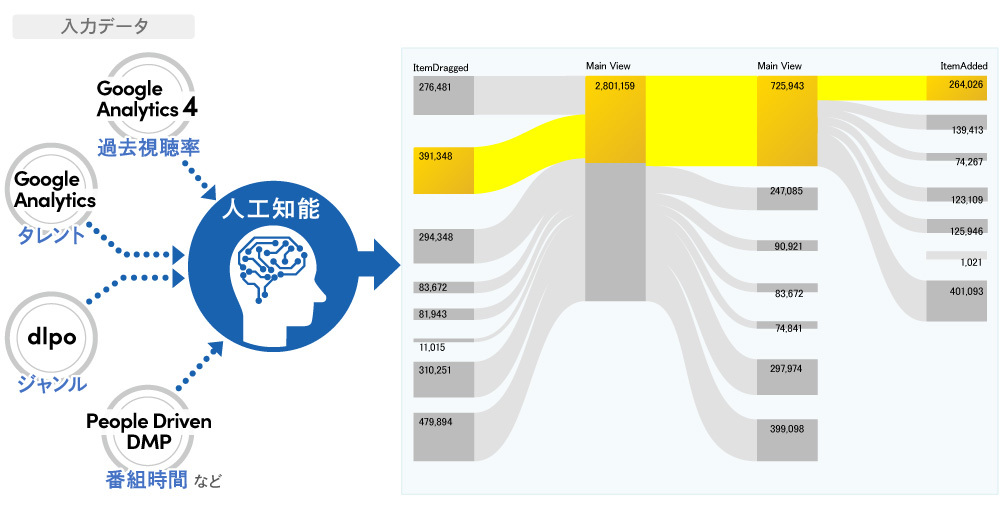
<Table of Contents>
▼Optimize Conversion Rates! The Case for CRO
▼Case Study 1: AI Identifies Customer Nuances & Segments. Personalization Using Data Drives Annual Sales Surge!
(Supports CV Paths by Inbound Channel)
▼Case Study 2: AI Finds the "Golden Path" with Ideas Humans Can't
(Supports Overall CV Paths)
▼Case 3: Experience design for users in "negative flow" doesn't fixate on conversion
(Supports negative paths that encourage abandonment)
▼ "AI × Growth Hacking" propelled CRO to the next dimension
▼What's needed in an era where "data maximizes while users remain invisible"?
Why not use AI to derive the "Golden Path" that guides users to conversion?
If the ultimate goal of website operation is revenue growth, CRO (Conversion Rate Optimization) directly linked to sales is indispensable.
Amidst the turbulent waves of DX, many companies struggle with utilizing user data. But what if analyzing that data with AI could improve your site's conversion rate?
In this article, Shunichi Yoshimura, Growth Consultant at Dentsu Digital Inc., explains conversion rate optimization using the latest AI.
※1=Conversion (CV)
Refers to all actions deemed a change in user attitude on a website, including "purchases" of products, "downloads," and "requesting materials."
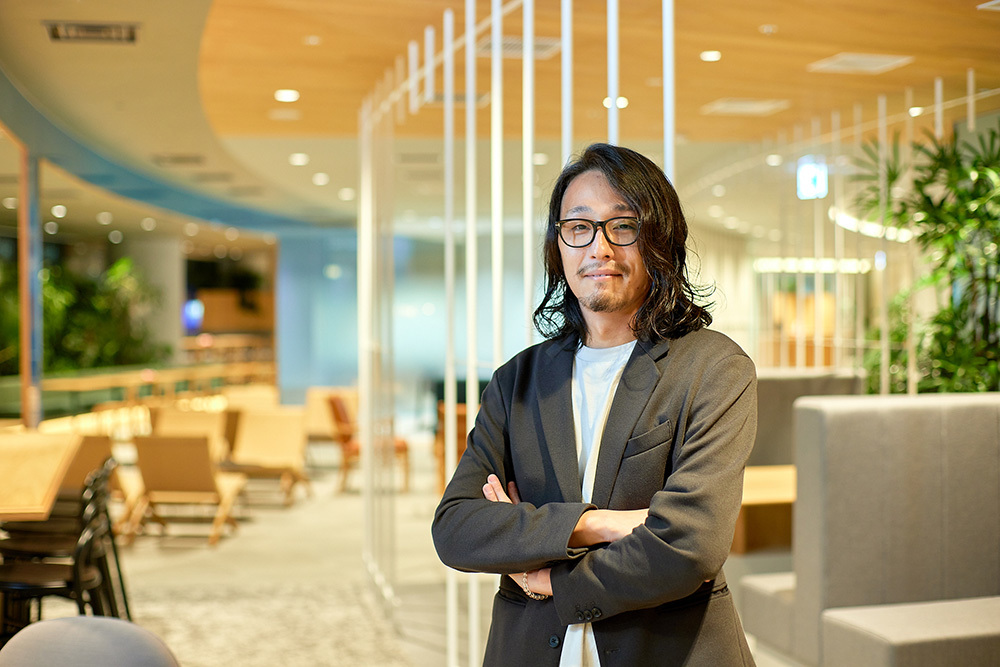
【Shunichi Yoshimura Profile】
Dentsu Digital Inc.
Experience Production Division, Growth Consulting Business Unit, CRO Group
Group Manager / Chief CRO Strategist
With 12 years of digital marketing experience since joining a financial company in 2011. After serving as Head of the PR Department/Web Business Division at an insurance agency and Head of Services for the CRO Division at a web consulting firm, he joined Dentsu Digital Inc. as a dedicated CRO specialist. Leveraging broad digital marketing skills and know-how, he handles everything from persona analysis and issue identification to high-level design and execution phases. His areas of expertise include design, front-end engineering, SEO, CRO, and web advertising operations.
Optimize Your Conversion Rate! The Case for CRO
<DENTSU Digital Inc. PR Release>
Partnering with Data Artist to Package "AI-Driven Conversion Rate Improvement Service"
https://www.dentsudigital.co.jp/news/release/services/2021-1209-001139
──First, could you explain what CRO is?
Yoshimura: CRO stands for Conversion Rate Optimization. While SEO (Search Engine Optimization) for improving search rankings is widely known in Japan, I feel that even among those involved in digital marketing, there is still limited understanding of CRO, which contributes more directly to sales.

──For example, how do you increase conversion rates?
Yoshimura: There are various methods, but one longstanding approach is "issue-driven." While using A/B testing for verification remains standard practice today, the issue-driven approach involves identifying problems, designing multiple improvement patterns, and then using test results to drive the next PDCA cycle. For instance, testing the size, position, or text of a product's CTA (Call To Action) button. This method focuses less on analyzing the current state or conducting surveys, and more on executing based on hypotheses and deriving insights from the results.
However, Dentsu Digital Inc.'s CRO approach differs from these traditional methods. The primary difference lies in its foundation on "growth hacking" principles. Beyond the "issue-driven" approach mentioned earlier, it also incorporates "data-driven" thinking. Additionally, the data analyzed is cross-functional. AI is utilized for this data analysis. Crucially, it doesn't stop at analysis alone; it commits to strategic planning and executing PDCA cycles to drive actual revenue growth for clients. I'll discuss the details later.
──What particularly interests me is the use of AI for analysis.
Koumura: When it comes to data analysis, AI has three distinct characteristics:
- Identifying patterns within data
- Identifying reproducibility from data
- Identifying precursors from data
Attempting to analyze these aspects manually requires significant time and effort. By visualizing user behavior based on the full volume of data from our clients' websites, we were able to capture "conversion indicators" and "drop-off indicators." Based on this, we design user flow paths determining which users should be directed where.
Using AI significantly reduces analysis time and, crucially, allows us to highlight meaningful user patterns within vast datasets. We'll discuss details later, but to give you an idea of "How does Dentsu Digital Inc. leverage AI for CRO?", we present three case studies here:
Case 1: AI Identifies Customer Nuances & Segments. Data-Driven Personalization Leads to Surge in Annual Sales!
(Supports conversion paths by traffic channel)
Yoshimura: The first case involves a client in the financial industry. Here, our CRO initiatives achieved a 120% improvement in conversion rate (CVR).
What we actually did was implement 1-to-1 personalized communication tailored to each traffic channel. Using AI, we identified conversion signals across every channel and funnel and optimized them.
Our analysis covered the full data set of users flowing from owned and paid media to the landing page (LP). What we discovered was that user behavior on the site differed completely depending on the entry channel. Users never exhibit identical behavior. In other words, the "need" of the user is already different at the moment of entry.
For example, users arriving via affiliate links likely already understand information A, so they might be seeking information B. Or, for users arriving from ads, we present different information than what was in the ad. We display content tailored to the user's motivation and intent upon arrival. Before implementing CRO, our landing pages (LPs) presented all information indiscriminately to every diverse user, regardless of their specific needs or motivation.
Furthermore, our AI analysis targets more than just the traffic channel. We capture all information: which pages they interacted with, whether their visit occurred on a weekday, during the day, or at night. We used all this data to design the personalization.
For example, users arriving at this page on a "weekend night" likely only have limited time for information gathering and probably have high urgency. Therefore, we provide them with messages like "We accept applications 24 hours a day" or "We can handle requests even on weekends or holidays." As a result, users accessing the page at that time recognized through this personalization that the product fit their needs, leading to a dramatic increase in conversion rates.
Case 2: AI Discovers the "Golden Path" Through Human-Defying Innovation
(Applies to the entire conversion path)
Yoshimura: The second case is in the beauty and fitness industry. Here, we implemented "experience design" within the page.
When users enter the site, they have diverse needs and appear to move around freely. However, analyzing all this data with AI reveals the "most concentrated route." We call this the "Golden Path" (primary flow).
For example, at Shibuya's scramble crossing, massive crowds move through day and night. If we overlay red lines only on the paths most people take to enter a specific coffee shop, that becomes the "primary route."
AI then takes this further, analyzing down to the level of "What actions do people take before entering the cafe and ordering coffee?" It reveals user behavior with incredible detail, like "People who touched the Hachiko statue and then stepped on every white line while moving ended up ordering coffee at a specific cafe."
What was fascinating this time was the gap between the assumed user behavior leading to conversion and the golden path discovered by AI. We had designed the journey map assuming shorter, clearer paths would lead to better conversion. However, AI analysis revealed users were actively seeking "the information they truly wanted," which actually increased conversion rates. In other words, the behavior of seeking information on different pages before directly converting showed "signs of impending conversion."
The conclusion was that the information users sought and their pain points weren't being fully addressed by the shortest possible path alone. The conventional approach would be to make the path to the goal—the entry form—as efficient, short, and easy as possible. However, based on the AI analysis, we deliberately designed it to "increase the number of pages and incorporate an experience where users engage with information."
On these additional pages, we explained the benefits of applying and provided information to alleviate user concerns.
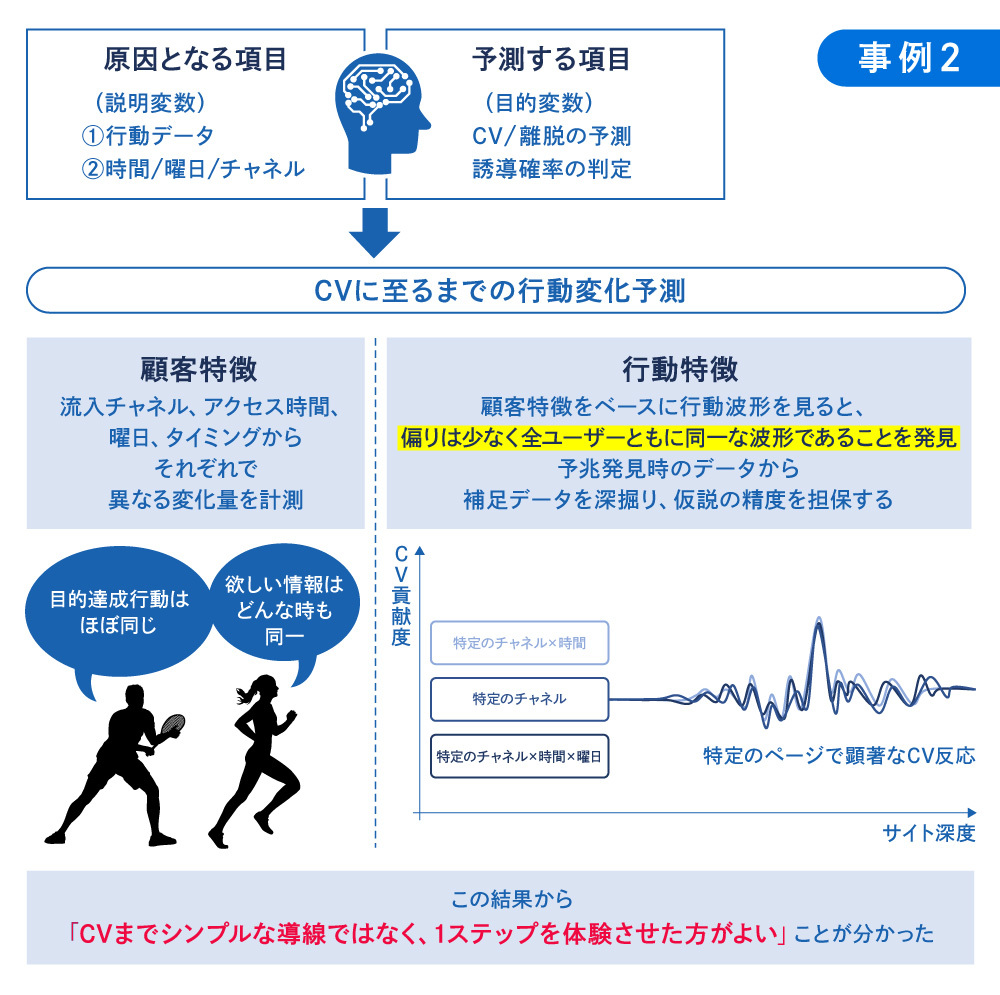

As a result, the conversion rate improved significantly. However, the idea of "deliberately deviating from the path and adding pages" is something humans would rarely come up with on their own.
By interpreting facts derived from AI and translating them into actionable strategies, we support revenue growth.
Case 3: Experience design for users in the "negative flow" doesn't fixate on conversion
(Addressing paths that encourage abandonment)
Yoshimura: The third case involves the financial and telecommunications industries. We conducted AI analysis across all domains, from owned media and paid media websites to advertising landing pages.
The results revealed communication issues with users, not just in areas directly linked to sales, but also beyond simple conversion increases. What does this mean? First, examining user inflow behavior revealed two distinct patterns.
The first is called the "nurturing flow." This is a path that increases the probability of conversion, such as "users who navigate specific pages and deepen their engagement show higher signs of impending conversion, so they should be guided along this path." This is also a golden path.
The second is called the "Negative Flow." Once users enter this route, they inevitably abandon the site. It's essentially a path that, from a conversion perspective, is better avoided.
When humans handle CRO, they often focus solely on steering users toward the nurturing flow. However, the same approach won't convert users on the negative flow. Their motivation isn't conversion; they're leaving because they couldn't solve some problem.
In this case, we determined that fundamentally changing how we engage with users through improved communication was optimal. Since users were experiencing anxiety before reaching conversion, we reasoned that using chat or similar tools for closer communication, rather than relying solely on the website, would be more effective.
Alternatively, if the website cannot alleviate their concerns, shifting the platform to a communication tool like LINE and changing the nature of the interaction is another approach. This represents an optimization that goes back to the core strategy itself.
The key takeaway from this case is that "it's not always necessary to push every user toward conversion immediately."
This includes users who have already converted but are visiting just to gather information, or users in the research phase who are considering options. Rather than forcing them onto a conversion path, we must also prepare experiences tailored to these users without disrupting their journey.
This case demonstrates how, alongside CRO, providing chat tools or web-based customer service that reassures users—even if it doesn't directly lead to sales—can help create and discover new needs and deepen customer understanding.

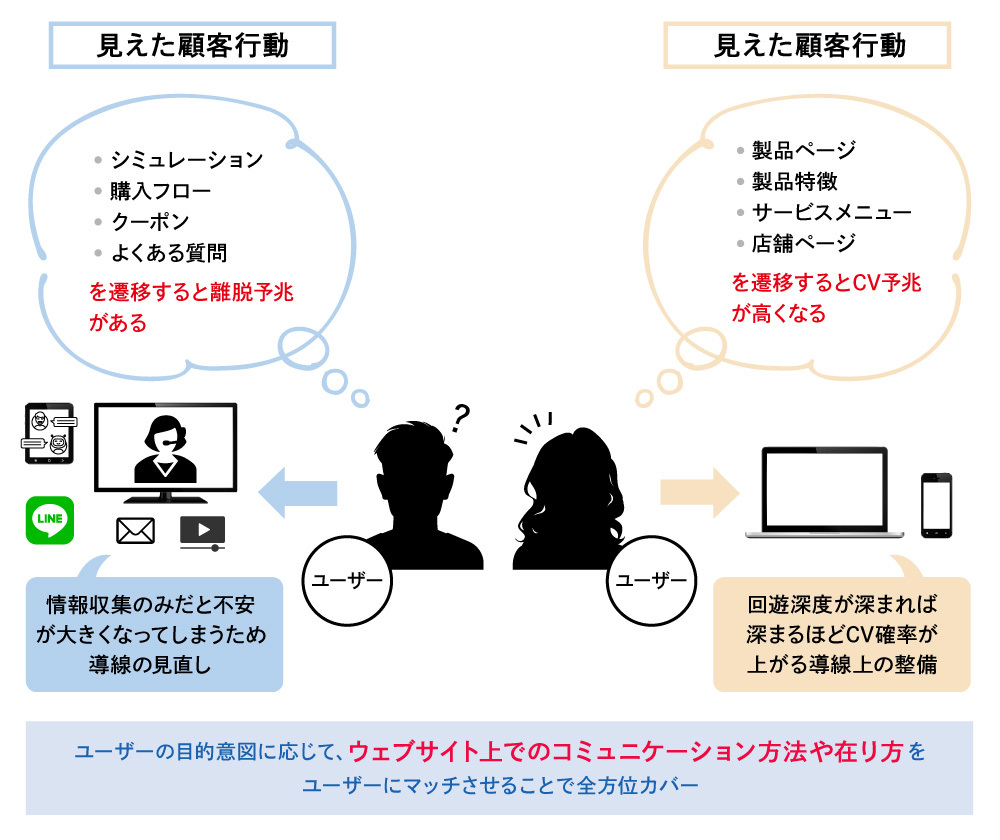
By visualizing user behavior on the site regardless of industry or business type,
- Identifying conversion paths based on user differences across traffic channels
- Identify the target group with the greatest impact on conversions from the overall conversion behavior trends of all users
- and identify actions that cause abandonment or reduced conversion motivation at the user moment level, not just per page.
has become easier.
"AI × Growth Hacking" has taken CRO to the next dimension
──I believe each of these three case studies contained groundbreaking elements. Now, could you tell us about your role as a Growth Consultant and how you came to focus on CRO?
Yoshimura: The role of a growth consultant is to accompany clients and support the growth of their services. Before joining Dentsu Digital Inc., I gained experience on the business side at a financial company and at a digital marketing consulting firm. What I came to understand during that time is that when formulating digital marketing strategies, the core question always boils down to how to achieve the company's ultimate goal: expanding revenue, meaning increasing "sales."
SEO and advertising are important, but they only matter because they ultimately drive sales. Partial design isn't enough; you need to think about the "overall design" of how to increase sales. Yet, I felt there was an issue: conversion optimization, which is closest to the sales endpoint, wasn't being prioritized enough in Japan.
──Could you briefly explain this "AI-powered Conversion Rate Improvement Service"?
Koumura: After the pandemic, many companies have embraced DX in recent years, increasing the demand for "data utilization." Our service analyzes the full volume of data clients possess—specifically, "what actions users take on their sites"—using AI to drive conversion rate improvement. This is the "AI-powered Conversion Rate Improvement Service" jointly developed by Dentsu Digital Inc. and Data Artist.
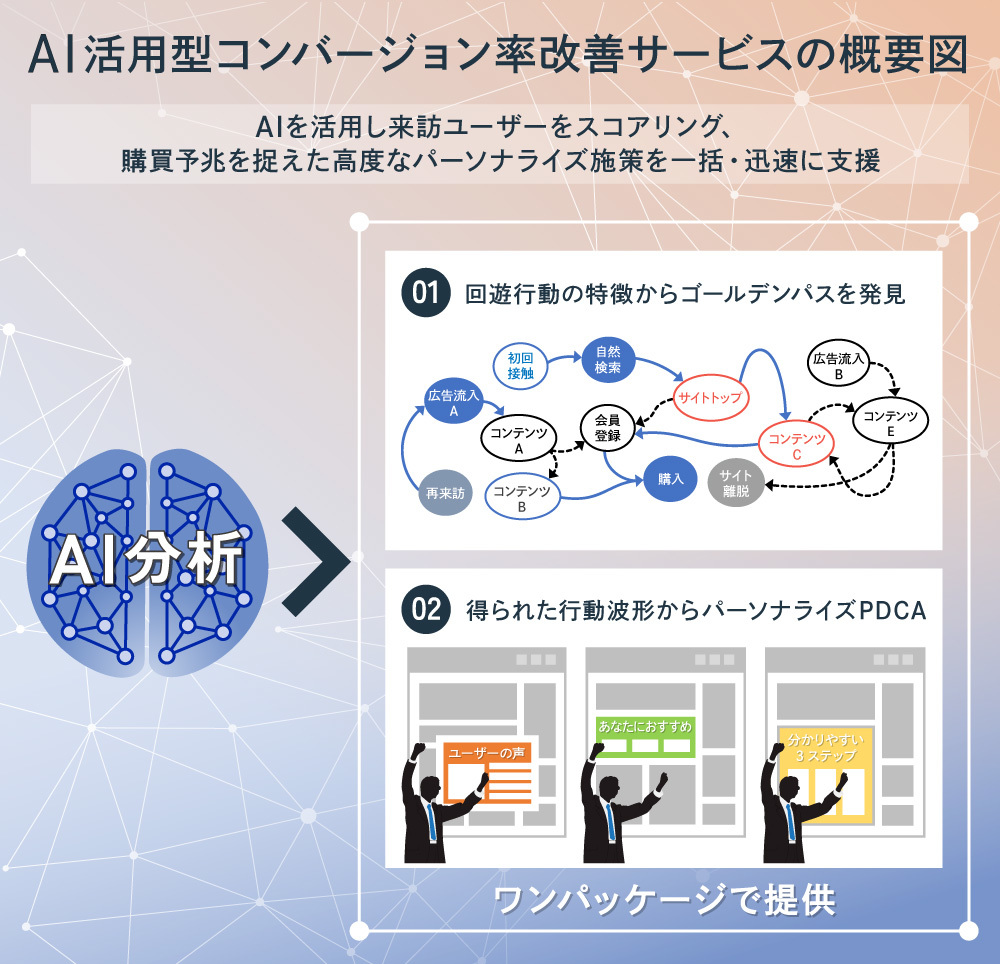
──What challenges existed when humans analyzed data? And how does AI solve those challenges?
Yoshimura: Humans can indeed reverse-engineer data from "users who converted" to infer "what user actions led to conversion?" However, analyzing the actions of "users who abandoned" was difficult because there are "infinite possible interpretations" linking those actions.
Therefore, we reasoned that by leveraging AI's strengths—such as "identifying common characteristics," "discovering reproducibility," and "predicting actions from precursors"—we could pinpoint the conditions: what actions cause users to abandon, and conversely, what actions prevent abandonment.
That said, AI can only handle "feature discovery," "reproducibility calculations," and "signal detection." Optimizing based on AI-discovered results requires growth consulting expertise.
Applying growth consulting methodologies to AI enables
- Visualization of user site behavior and challenges
- Dramatically improve conversion rate optimization accuracy
- and compress the time required for analysis, implementation of measures, and the PDCA cycle.
This service achieves these goals. Compared to human analysis, it drastically reduces the analysis period and dramatically increases the speed of the PDCA cycle. This speed is a major benefit of leveraging AI.
──What inspired the idea of analyzing client-owned user data with AI and applying it to CRO?
Yoshimura: User data is essentially the voice of the user. However, this data is often siloed across different tools, solutions, or departments within a company, preventing cross-functional analysis. As growth consultants, we frequently observed clients failing to fully utilize their data. Even attempting to analyze vast datasets with AI requires enormous costs and time to implement. This leaves valuable data untapped for marketing.
That's why we thought combining our expertise in "growth hacking" (※2) with AI could help clients leverage their vast user data to drive revenue growth (data is collected in a form that cannot identify individuals).
──What is the biggest difference between traditional consulting and this service?
Yoshimura: The defining feature of Dentsu Digital Inc.'s CRO lies not in the AI itself, but in its foundation on "Growth Hacking," a concept proposed by Sean Ellis in 2011. Growth Hacking is a methodology for continuously improving new ventures and products. We've adapted this Growth Hacking model specifically for websites.
※2 = Sean Ellis / Morgan Brown, "Hacking Growth: How Today's Fastest-Growing Companies Drive Breakout Success," Currency (April 25, 2017)
A key characteristic of growth hacking is its data-driven approach. Rather than being issue-driven, it discovers "features" and "signs" from vast amounts of data, deriving challenges and problems from previously unseen site behaviors and customer profiles.
Another strength is the ability to combine the full volume of website behavioral logs with the attribute data from the People Driven DMP owned by the Dentsu Group. By cross-referencing "behavioral data" with "attribute data," this service enables highly accurate user behavior analysis centered on the individual (data is collected in a form that does not identify personal information).
People Driven MarketingⓇ
https://www.dentsudigital.co.jp/services/communication/ax/pdm
──Interpreting insights from AI-analyzed data requires a certain level of human skill and expertise, right?
Koumura: Yes. We believe that's where our value lies. AI tends to jump straight to the "conclusion," but the real challenge—and the most critical point—is "what do we do with this conclusion?" That's where we step in. Leveraging our inherent CRO expertise and experience, we provide the full service: interpreting the data and translating it into actionable strategies.
The overall service framework is:
- Landing Page (LP) Access Analytics, Transition Analysis
- UI/UX research
- Planning and strategy formulation
- Action implementation
- Optimizing conversion rates through PDCA
That's the gist. We have highly skilled analysts who can provide value quickly and seamlessly, from analysis to executing the PDCA cycle. However, depending on the client or project, we can also support just part of this process. If unnecessary, we may propose approaches that don't use AI.
Furthermore, even for informational media without direct conversions, our expertise can increase user return visits, boost page views, and guide users to relevant content. This makes our approach highly versatile. For users, the benefit is accessing desired information and enjoying a smoother, richer experience.
What is essential in this era where "data is maximized yet the user remains invisible"?
──Please share your thoughts on how corporate digital marketing will evolve going forward and what companies must prioritize.
Koumura: DX will accelerate further, and the solutions and tools used in digital marketing will continue to multiply, meaning companies will possess even more massive amounts of "data" than they do now. Additionally, "siloing" across tools, departments, and projects will become a problem.
The strength of digital lies in its ability to verify effectiveness through metrics. While numbers become a powerful communication tool, companies often possess all these metrics yet fail to leverage them for deeper user understanding.
In this era, the skills needed to cross-analyze vast siloed data and connect it to revenue growth will diversify. We aim to assist with these decisions and accompany clients and their businesses as they grow.
We aim to uncover what users want by analyzing existing users, thereby achieving "growing the user base" and "increasing revenue from current users by providing more optimal experiences." By driving up key business KPIs, we want to contribute to our clients' success.

Was this article helpful?
Newsletter registration is here
We select and publish important news every day
For inquiries about this article
Author

Shunichi Yoshimura
Dentsu Digital Inc.
Since joining a financial company in 2011, I have 12 years of experience in digital marketing. After serving as Head of the Public Relations Department/Web Business Division at an insurance agency and Head of Services for the CRO Division at a web consulting firm, I joined Dentsu Digital Inc. as a dedicated CRO specialist. Leveraging extensive digital marketing skills and expertise, I handle everything from persona analysis and issue identification to high-level design and execution phases. My specialties include design, front-end engineering, SEO, CRO, and web advertising operations.



